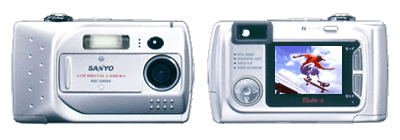A Sanyo VPC-SX550 FAQOk, I'm writing this because this camera is *rad* and nobody seems to have any real user info about it on the net. I use this camera primarily as a compact video camera. I happen to have the VPC-SX550MD. The only difference, the "MD", stands for the 340 meg Microdrive they throw in. Got it on Ebay for 500 smackers. The VPC-SX500 is very similar but is limited in it's continuous shooting modes and has no USB. A couple of big questions firstThe first logical question: "What's the quality like?" A: Visually, great. But there's a problem with sound. Because the microphone is in the case right next to the Microdrive there is quite a lot of hum, not to mention the mechanical noise from pressing buttons on the body. I've decided that I'm going to have to filter all the audio I record while using the Microdrive. I'm working out some EQ settings to cancel the noise and thinking CompactFlash. Before I bought it, I saw a compromise in that you could not shoot 30FPS at full VGA resolution. The main question I had when I first opened this thing was, "What's the best resolution and frame-rate to shoot at?" A: I think it's 320x240 Fine @ 30FPS. At that setting you can get about 9 minutes of video on a 340 Meg Microdrive. I think that a few cheap 256Meg CompactFlash cards ($150 right now 7-11-2001) should match up nicely with the 5 minute uninterrupted recording limit on these beasts. My Review / Market ComparisonThis is what I wanted: A highly portable video device for short films. I have a little Sony DV camera but it's not going to go into my jacket pocket when I walk down to the cafe. But that's when I see stuff I want to film. There is no competition for this thing on the market and at the time of writing, it's been out for a year. This is amazing to me but every digicam on the market has lame video specs comparatively. The Canon Elph 110 and 330 are the best I could find but they only go to 20FPS. For some reason their data rate for 640x480 video (at 2Mb/s) is 3 times the size of the Sanyo and they max out at 30 seconds per take no matter what kind of storage you have (and you can't use a Microdrive). When people see me using it they're stunned. Most people didn't know digital cameras could make movies. This is not the best digital camera on the market, nor as good as the Canon's listed above. The highest resolution is a measly 1360 x 1024, there are no "prosumer" features and it doesn't zoom. (I hate zooms anyhow). But it records video better than the newest $3000 Canon or Nikon. Sanyo's website has a handy specs chart in case you're curious. One note about the software: Movies in the dark: MediaCleaner Settings: I'm not going to exhaustively list the features of this camera. Nobody's paying me to do this and I needed to write this for my own reference more than anything. Besides, it's a pretty simple little digital camera and you should always read the manual. I'll add gripes as I come up with them.
|
|
|||||||||||||||||||||||||||||||||||||||||||||||||||||||||||||||||||||||||||||||||||||||||||||||||||||||||||||||||
Quicktime (Motion JPEG) Video Capture DataThe table below lists the only settings I recommend using. 160x120 is a joke. You may end up putting it on the web at 160x120 but I'd rather capture at a higher quality for archive purposes. You can't go back and shoot it again. (Following this reasoning will eventually make you end up spending a lot of money on better gear but I think this camera has a good price/performance/size ratio.) This chart assumes that you will always recompress with a real video codec like MPEG-4 or Sorenson. Motion Jpeg has no temporal compression and it is not what you'd want to put up on your website. Say, for example, that your final target is 160x120 @ 10fps and lots of compression so modem users can watch it. You're still better off starting with the highest quality because the video codec you choose will compress clean video better than one with lots of Jpeg artifacts. You will get a smaller, better looking file in the end.
Still Sequence Capturing DataThe Sanyo website is lists the sequential image mode statistics incorrectly. This is from the manual and confirmed by my testing. I like this mode as an alternative to still photography, not as a substitute for video. There is no sound and the times are just too short. However, the limitations of just having a couple of seconds can make for interesting creative possibilities. Notice that 640x480 Normal @ 15fps is limited to 3.3 seconds but in video mode you can shoot exactly the same resolution for 5 minutes.
|
||||||||||||||||||||||||||||||||||||||||||||||||||||||||||||||||||||||||||||||||||||||||||||||||||||||||||||||||||


